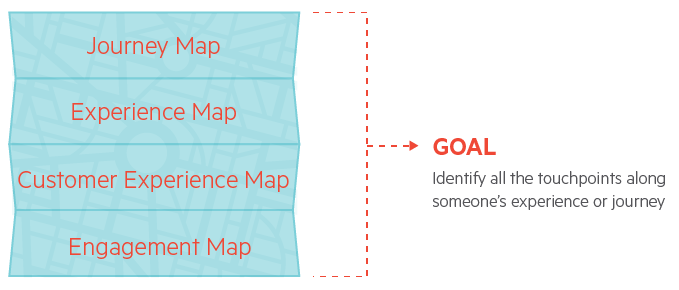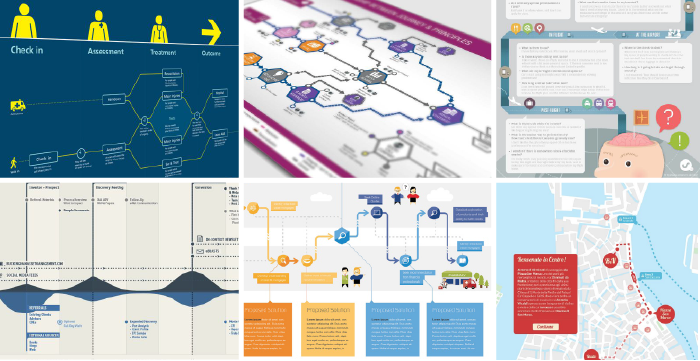Blog Insights
Improving User Experience Through Journey Maps
Regardless of the actions you want your audience to take, you should provide an experience where they are able to successfully interact with your organization. Journey maps help us to understand their current experience, so that we can then work to improve it. Let’s dive deeper into how a journey map helps us accomplish this!
 At its simplest, a journey map identifies all the touchpoints a person might encounter while trying to complete a task. User Experience (UX) professionals have a variety of names for journey maps — such as experience maps, customer experience maps, and engagement maps. They vary in detail and focus; however, for our purposes, we will stick with a simple definition.
At its simplest, a journey map identifies all the touchpoints a person might encounter while trying to complete a task. User Experience (UX) professionals have a variety of names for journey maps — such as experience maps, customer experience maps, and engagement maps. They vary in detail and focus; however, for our purposes, we will stick with a simple definition.
A journey map for a metro commute experience would include the above tasks and touchpoints, and likely many more. If the metro system was interested in improving its operations (i.e., increasing the usage of different tools they offer, making people’s commutes easier, etc.), one of its first steps should be to document all touchpoints within a journey map.
 Also, while you may want users to follow one primary path, each user is unique and will often take a different set of steps to complete a task, depending on where they enter your platform, and the perspective they bring. In this case, it’s worth considering and accounting for multiple navigation paths.
Also, while you may want users to follow one primary path, each user is unique and will often take a different set of steps to complete a task, depending on where they enter your platform, and the perspective they bring. In this case, it’s worth considering and accounting for multiple navigation paths.
What is a journey map?
 At its simplest, a journey map identifies all the touchpoints a person might encounter while trying to complete a task. User Experience (UX) professionals have a variety of names for journey maps — such as experience maps, customer experience maps, and engagement maps. They vary in detail and focus; however, for our purposes, we will stick with a simple definition.
At its simplest, a journey map identifies all the touchpoints a person might encounter while trying to complete a task. User Experience (UX) professionals have a variety of names for journey maps — such as experience maps, customer experience maps, and engagement maps. They vary in detail and focus; however, for our purposes, we will stick with a simple definition.
What is a touchpoint?
A touchpoint is any point at which your organization and a user interact, either online or offline. Let’s look at a real-world example of touchpoints you might encounter while commuting on a metro (or subway).Example metro commuting tasks & touchpoints
| TASK | TOUCHPOINT |
|---|---|
| Look up directions to destination and choose a route | Google map, Metro map (printed), Metro website |
| Add money to my SmarTrip Card | SmarTrip machine (in station), Metro website |
| Enter Metro station | Metro turnstile |
| Time to the next train | Metro train status board, Metro app |
| What stop are we at? | Metro conductor announcements, Phone GPS |
| When is the Metro closing down this weekend? | News, Metro website |
How does a journey map help my organization’s digital properties?
The journey maps we create most often focus on the online journey between an organization and its primary audience. We work with organizations that have complex systems and many people involved, and so journey maps help us to successfully build or redesign complex their digital platforms. The flow and overall user experience can work seamlessly if we understand the tasks and touchpoints to refine these interactions. Your main goal is for your audience to successfully interact with your organization. So let’s dive deeper into how a journey map helps you to accomplish this.From start to end
Every user takes a “journey,” from the moment they first become aware of your organization, to the decision points through which they begin to explore what you have to offer, to the conversion endpoints where they become more deeply and actively engaged with you. By identifying these touchpoints for your various audiences, you are able to discover what actions and content lead your audiences throughout their journeys. A journey map is then developed to compile this information in a useful way.The complete picture
A journey map is a framework that enables you to improve your customer experience. It documents the customer’s experience through their perspective, ultimately enabling you to best understand how customers are currently interacting with you and identify areas for improvement moving forward. By investing time in understanding the path/journey a customer takes, the people/functions they interact with along the way, and other enablers/obstacles that cross their paths, a journey map will provide a complete picture of the customer experience.Creating lots of variety
Since each journey map is unique to the organization and audience it intends to reach, it can vary widely in what it displays. It can take into account both the online and offline interactions a person may have. It may also highlight your audience member goals, and how they go about achieving those goals. Journey maps may display only one audience’s journey, or multiple audiences’ journeys. Additionally, they have varying levels of information depending on what research and analysis show. It can include one or many engagements and touchpoints as well; there’s no magical number, just whatever fits your organization. Also, while you may want users to follow one primary path, each user is unique and will often take a different set of steps to complete a task, depending on where they enter your platform, and the perspective they bring. In this case, it’s worth considering and accounting for multiple navigation paths.
Also, while you may want users to follow one primary path, each user is unique and will often take a different set of steps to complete a task, depending on where they enter your platform, and the perspective they bring. In this case, it’s worth considering and accounting for multiple navigation paths.
When does a journey map make sense?
Journey maps are most needed in situations where you have:- multiple touchpoints (e.g., a touchpoint is any time where you and your audience interact)
- multiple, complex actions (e.g., multi-step processes, complicated application processes)
- multiple people (e.g,. when there’s hand-off between people in a single process: approvals, reviews, etc; or when multiple people are doing a task at the same time)
- multiple tools or online and offline activities (eg. when there are multiple tools or sites with which a person may interact in order to complete a task)
- defined beginning and end (e.g., application process, data submission)
- existing bad experiences (e.g., people don’t know what the next step is, aren’t able to efficiently complete a set of steps, or are unaware when efforts are duplicated)
How do journey maps help you improve the digital experience?
A journey map helps to:- plan a site redesign and/or updates to account for your organization’s various audiences and their needs at every touchpoint
- evaluate an audience’s current journey to identify gaps or issues
- highlight areas of improvement and areas of opportunity throughout audience members’ current journeys
- identify ways to draw the user further into a digital ecosystem or from touchpoint to touchpoint
- question which steps are absolutely necessary to move forward and which are actually potential distractions.
Current vs future
We often find that even the first step of charting out the audience’s current journey can be incredibly useful for our clients. The primary goal of the current state journey map is to build a better understanding of your audience’s interactions with your organization. The process of creating a current state journey map requires a deep understanding of your users, which often means bringing in research and multiple members of your team. This means that while you are building a better understanding of your audience, you are also creating alignment on your team. Once you’ve created your current state journey map, you then analyze it and look for pain points, gaps and opportunities to improve. This can then open the conversation to ideation, through activities such as How Might We questioning. After determining which ideas your team wants to test, map them in a future-state journey map. The primary goal of creating a future-state journey map is to provide your team with an aspirational target and test if your new ideas will indeed improve the user experience.How to get started
Take the leanest route
- Determine your priority audience and the tasks that they complete when interacting with your organization (i.e., the process of using your website).
- Write out all the touchpoints that are involved with completing these tasks
Level up
- Conduct audience research to better understand your audience’s goals, needs, and pain points.
- Use this research to directly inform and update the journey map.
Keep going
- Fill out the entire journey map. This is your current state map.
- Work with your team to identify where there may be pain points, gaps, and opportunities to improve.
- Ideate on how to improve this process. This becomes your future-state map.
- Next: put it into action!